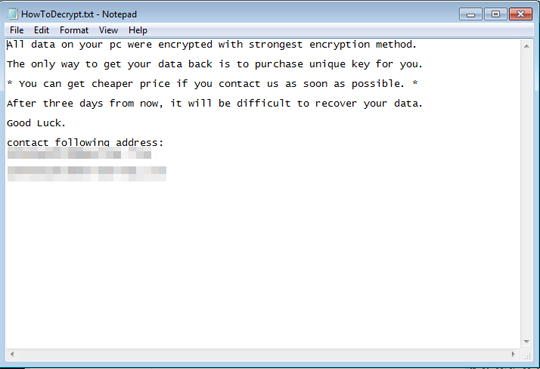Ransom.Win32.VHDLOCKER.A
Windows


Threat Type: Ransomware
Destructiveness: No
Encrypted: No
In the wild: Yes
OVERVIEW
This Ransomware arrives on a system as a file dropped by other malware or as a file downloaded unknowingly by users when visiting malicious sites.
It drops files as ransom note.
TECHNICAL DETAILS
Arrival Details
This Ransomware arrives on a system as a file dropped by other malware or as a file downloaded unknowingly by users when visiting malicious sites.
Installation
This Ransomware drops the following files:
- {malware path}\Chop.BAIP
It adds the following mutexes to ensure that only one of its copies runs at any one time:
- AEEAEE SET
Other Details
This Ransomware does the following:
- It stops the following services:
- Microsoft Exchange Active Directory Toplogy
- Microsoft Exchange Anti-spam Update
- Microsoft Exchange Compliance Audit
- Microsoft Exchange Compliance Service
- Microsoft Exchange DAG Management
- Microsoft Exchange Diagnostics
- Microsoft Exchange EdgeSync
- Microsoft Exchange Frontend Transport
- Microsoft Exchange Health Manager
- Microsoft Exchange Health Manager Recovery
- Microsoft Exchange IMAP4
- Microsoft Exchange IMAP4 Backend
- Microsoft Exchange Information Store
- Microsoft Exchange Mailbox Assistants
- Microsoft Exchange Mailbox Replication
- Microsoft Exchange Mailbox Transport Delivery
- Microsoft Exchange POP3
- Microsoft Exchange POP3 Backend
- SQL Server Agent (TESTINSTANCE)
- SQL Server (TESTINSTANCE)
- It tries to delete any folder named "System Volume Information" if it is found empty
- It encrypts every file (except for those it avoids) with extension regardless if it's a legitimate extension or not
Ransomware Routine
This Ransomware avoids encrypting files with the following strings in their file name:
- Chop.BAIP
- HowToDecrypt.txt
It avoids encrypting files with the following strings in their file path:
- Windows
It avoids encrypting files found in the following folders:
- System folders and files
It appends the following extension to the file name of the encrypted files:
- .vhd
It drops the following file(s) as ransom note:
- {Drive Letter}\HowToDecrypt.txt
- %Desktop%\HowToDecrypt.txt

SOLUTION
Step 1
Trend Micro Predictive Machine Learning detects and blocks malware at the first sign of its existence, before it executes on your system. When enabled, your Trend Micro product detects this malware under the following machine learning name:
- Troj.Win32.TRX.XXPE50FFF034
Step 2
Before doing any scans, Windows 7, Windows 8, Windows 8.1, and Windows 10 users must disable System Restore to allow full scanning of their computers.
Step 3
Note that not all files, folders, and registry keys and entries are installed on your computer during this malware's/spyware's/grayware's execution. This may be due to incomplete installation or other operating system conditions. If you do not find the same files/folders/registry information, please proceed to the next step.
Step 4
Search and delete these files
- {Drive Letter}\HowToDecrypt.txt
- %Desktop%\HowToDecrypt.txt
- {malware path}\Chop.BAIP
Step 5
Scan your computer with your Trend Micro product to delete files detected as Ransom.Win32.VHDLOCKER.A. If the detected files have already been cleaned, deleted, or quarantined by your Trend Micro product, no further step is required. You may opt to simply delete the quarantined files. Please check the following Trend Micro Support pages for more information:
Step 6
Restore encrypted files from backup.
Did this description help? Tell us how we did.

